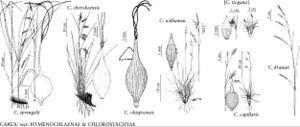Difference between revisions of "Carex sprengelii"
Syst. Veg. 3: 827. 1826.
imported>Volume Importer |
imported>Volume Importer |
||
| Line 55: | Line 55: | ||
|publication year=1826 | |publication year=1826 | ||
|special status=Illustrated;Endemic | |special status=Illustrated;Endemic | ||
| − | |source xml=https:// | + | |source xml=https://bitbucket.org/aafc-mbb/fna-data-curation/src/2e0870ddd59836b60bcf96646a41e87ea5a5943a/coarse_grained_fna_xml/V23/V23_868.xml |
|genus=Carex | |genus=Carex | ||
|section=Carex sect. Hymenochlaenae | |section=Carex sect. Hymenochlaenae | ||
Latest revision as of 20:43, 5 November 2020
Plants with short-creeping rhizomes, loosely cespitose, forming colonies. Culms brown at base, densely covered with brown fibrillose remains of previous year’s leaves; flowering stems 30–90 cm, longer than leaves at maturity, 0.5–0.7 mm thick, glabrous but finely scabrous within inflorescence. Leaves: sheaths glabrous, basal ones tinged with brown and all bearing blades, green to hyaline on back, white-hyaline on front; blades flat, 2.5–4 mm wide, finely scabrous on adaxial surface and margins, glabrous on abaxial surface. Inflorescences: peduncles of lateral spikes slender, 20–60 mm, equaling or somewhat longer than spikes, finely scabrous; peduncle of terminal spike 5–15 mm, scabrous; proximal bracts equaling inflorescences or more often shorter; sheaths 3–5 mm or rarely longer; blades 1–1.5 mm wide. Lateral spikes 4–5, 1 per node; proximal spikes well separated, nodding or drooping at maturity, pistillate with 10–40 perigynia about 1 mm apart, cylindric, 10–35 × 8–10 mm; distal spikes crowded near apex, sessile or nearly so, staminate or androgynous, linear, less than 20 mm. Terminal spike staminate or rarely with a few perigynia at base, 10–20 × 1.5–2 mm. Pistillate scales pale hyaline tinged with chestnut, narrow midrib green, sometimes finely scabrous, ovate-oblong, shorter than mature perigynia, apex long-acuminate, glabrous. Perigynia shiny tan to golden green, 2-ribbed, but otherwise veinless, closely enveloping achene at maturity, ovoid-ellipsoid, 4.5–6.5 × 1.5–2 mm, membranous, base acute, apex abruptly contracted to beak, glabrous; beak bidentate, narrowly tubular, nearly as long as body, finely scabrous on edge, teeth hyaline, 1 mm. Achenes substipitate, 2–2.5 × 1.7–1.8 mm. 2n = 42.
Phenology: Fruiting early to mid summer.
Habitat: Dry to mesic deciduous forests and forest openings, floodplain forests and riverbanks, lakeshores, limestone river bluffs, mixed conifer-hardwood forests, thickets, meadows, roadsides, often associated with calcareous rocks and soils
Distribution

Alta., B.C., Man., N.B., Ont., Que., Sask., Colo., Conn., Del., Ill., Ind., Iowa, Maine, Mass., Mich., Minn., Mo., Mont., Nebr., N.H., N.J., N.Y., N.Dak., Pa., S.Dak., Vt., Wis., Wyo.
Discussion
Selected References
None.
